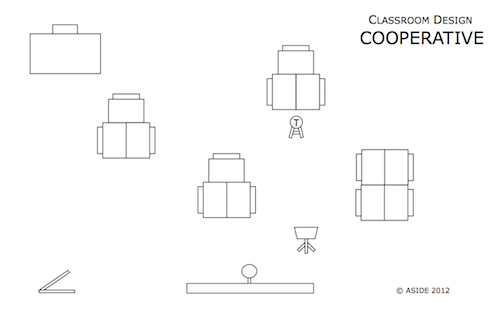Room layout ideally should be an extension of the learning. Adaptable designs allow for differentiation. They avoid a repetitive setting and instead customize the space for lessons. Redecorating enlivens the children's experiences and provides flexible room for technology or discussions. Feng shui harmony translates to the classroom, as the arrangement matters.
When students enter a classroom and encounter a new configuration, they appreciate both the unpredictability and the predictability. They like the change, even if unexpected, because it validates the importance of their daily scene. Students begin to anticipate the learning by the day's arrangement, which itself is a decoding, thinking skill. Keeping a classroom fixed is not inherently bad, but it does suggest that information delivery might be fixed, too. Not updating a design is like not changing a bulletin board or not refreshing a homepage -- certainly not a crime, but not ideal either.
Senatorial seating is our students' favorite design. They know the day will be mostly discussion-based, with plenty of visuals shared on the SMARTboard. The podium in the front is mostly pro forma, since we generally wander the classroom. Even in note-taking from PowerPoint or Prezi, the cozy, scalloped layout welcomes each child into the conversation and obviates the need for assigned or "preferential" seating. Students also know there probably won't be a pop quiz that day, given the close proximity of desks.
The seminar style provides the benefits of colloquy and sharing. Book discussions and writing workshops suit this format. The teacher sits at a chair in equal status as the students. No one is designated as the "leader." Socratic sessions, collaborative essays, and personal exchanges are all ideal here.
Cooperative groups obviously offer many benefits. The students instruct one another and solve problems in collaboration. The teacher can sit with whatever group needs extra attention. Differentiation, therefore, is essential in creating combinations, which will likely change depending on the day's activity.
Pairs are useful when students are sharing a laptop or are dissecting a text together. We happen to have an odd number of students, so the coupling is not always perfect. But the paired design is often an optimum arrangement for examining primary sources, handling manipulatives, or creating projects.
The partnered format is not the same as the paired design. Here, students face each other, which emphasizes face-to-face interaction. Again, the teacher can move from group to group, while the students work as lawyers and witnesses, Democrats and Republicans, or Montagues and Capulets.
In a debate, the teams need physical separation to plan their strategies. They also need clear sight lines to the opposing squad. The teacher at the podium has a minor role, as a student preferably would serve as the moderator at the desk. The SMARTboard is handy to record key points or to keep time.
Often our best classes occur when students don't take a single "note." In these cases, they might not even need desks. The theater design allows them to sit closely in chairs, without an artificial divide. The desks are pushed against the walls. The teacher becomes a spectator, as the group watches a film, takes turns at the SMARTboard, interacts with web 2.0 tools, or appreciates a peer's oral presentation.
Simulations turn the students into role-players, and the classroom can be made to mimic real-world contexts. We annually reenact a criminal mock trial with our seventh-graders, so this arrangement features a witness stand, a judge's bench, an attorney's podium, and council chairs. The desks are again against the walls. Other room role-plays could include a Congressional vote, a news broadcast, a Medieval castle, or a frontier campsite.
Update: Classroom Architect is a free, easy, interactive web tool to design sample layouts and move furniture in a virtual floor plan for your classroom.












I feel the above methods seems to have a broader impact. In Cempaka we have all the current innovative methods.Technology is making a drastic change in education .
ReplyDeleteI like this.
It is merely looking into the current needs of the students and educators. Itseems like looking at the existing products that are addressing the issue to find a solution. Some solutions are mashing two ideas together in a truly inventive way that can be applied to the students.
[Mrs.Usha]
Thank you for your feedback and your insights. They are much appreciated.
Deletevery good blogs on feng shui almost all the points are covered thanks!!
ReplyDeleteFeng Shui
ReplyDeleteWe offer a variety of Feng Shui products at our online store. Our high-quality Feng Shui items at affordable prices. For more details visit us.
to get more - https://brahmatellsstore.com/collections/feng-shui
Feng Shui for classroom design highlighted in this blog is interesting and could create conducive learning atmosphere.
ReplyDeleteGreat blog. Learnt a lot chinese zodiac compatability
ReplyDeletechinese Coins
Office feng shui
feng-shui-birth-element
chinese love symbols
chinese landscaping
Fantastic!! Teachers can easily ease their work with the blog
ReplyDeleteinteresting and have a broad impact indeed
ReplyDelete